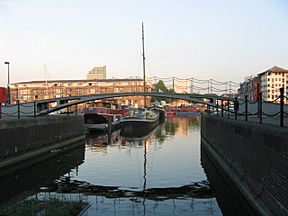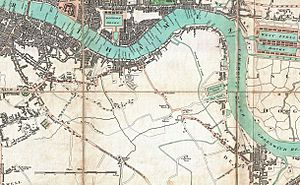Grand Surrey Canal facts for kids
Quick facts for kids Grand Surrey Canal |
|
|---|---|

The Norway Cut swing bridge crosses a channel from Greenland Dock to the closed Norway dock
|
|
| Specifications | |
| Maximum boat length | 109 ft 0 in (33.22 m) |
| Maximum boat beam | 18 ft 0 in (5.49 m) |
| Locks | 1 |
| Status | Closed. Partly infilled. |
| History | |
| Date of act | 1801 |
| Date of first use | 1810 |
| Date completed | 1826 |
| Date closed | 1970s |
| Geography | |
| Start point | Camberwell |
| End point | Surrey Commercial Docks, Rotherhithe |
| Connects to | River Thames |
The Grand Surrey Canal was a canal constructed in south London, England during the early 19th century. It opened to the Old Kent Road in 1807, to Camberwell in 1810, and to Peckham in 1826. Its main purpose was to transport cargo, primarily timber (or 'deal') to the Surrey Commercial Docks.
The Grand Surrey Canal closed progressively from the 1940s, with all but the Greenland Dock closing in the 1970s. Much of the route is traceable, as it has been turned into roadways and linear parks.
History
During the late 1700s, there were a number of proposals for canals on the south bank of the River Thames, and several of the prominent canal engineers of the time were involved. John Smeaton looked at two possible routes for a canal between Kingston upon Thames and Ewell in 1778. Ralph Dodd, who was also involved with promoting the Thames and Medway Canal, proposed a canal with a number of branches linking Deptford, Clapham, Kingston, Ewell, Epsom, Mitcham and Croydon. A plan for a canal from Croydon to Wandsworth was thought to be impractical by William Jessop and John Rennie, because the main source of water in the area through which it would run was the River Wandle, and this supplied a number of mills which would be affected if the river was used to supply the canal. Jessop also advised on a canal from Vauxhall to Rotherhithe in 1796, while in 1799, a railway from London through Croydon to Portsmouth, using horses to pull the wagons, was suggested. Eventually, three projects were submitted to parliament for approval. These were the Grand Surrey Canal, at the time called the Kent and Surrey Canal, the Croydon Canal linking Croydon and Rotherhithe, and the Surrey Iron Railway, a horse-drawn linking Croydon to Wandsworth, and all three were authorised in 1801.
The Grand Surrey Canal was authorised by an Act of Parliament obtained on 21 May 1801, which created the Company of Proprietors of the Grand Surrey Canal, and gave them powers to raise £60,000 by issuing shares, and an additional £30,000 if required. They were authorised to build a canal from Rotherhithe, on the River Thames, to Mitcham in what was then Surrey, with branches to any places within 1,500 yards (1,400 m) of the main line. Branches to Deptford, Peckham, the Borough, and one to rejoin the Thames at Vauxhall were included, but proposals for a branch from Mitcham to Croydon, and another to Kingston, which would have created a route to bypass the Thames through London, were removed from the bill during the committee stages. Those who opposed the canal ensured that clauses restricting use of water from the Wandle were inserted.
Work began on the canal, but at the same time, the London dock system was in its early stages of development, and there were proposals by John Hall in 1802 to construct a dock at Rotherhithe, close to the lock by which the canal gained access to the Thames. The canal company agreed to construct it in 1803, and although it was poorly funded, the 3-acre (1.2 ha) basin, together with a ship lock, was completed and opened on 13 March 1807. The Croydon Canal, which had also been authorised in 1801, proposed to join the Surrey Canal near Deptford, to save having to construct a parallel route to the Thames. The prospect of rent from this arrangement helped the company to open the first 3 miles (5 km) of the canal, as far as the Old Kent Road, in 1807, but their resolve to complete the canal had been lost, as the docks seemed a more lucrative prospect.
However, a second Act of Parliament, obtained in 1807, authorised them to raise another £60,000, which was used to extend the canal to Memel Wharf and a basin at Camberwell. This work was completed in 1810. So far, the route had been level, but to go any further would have needed locks or inclined planes, and the expected costs of their construction did not inspire the company to proceed with them. A short branch of about 1⁄2 mile (0.80 km) was constructed in 1826, running from Glengall Wharf to Peckham Basin. Two further acts of parliament were obtained in 1808 and 1811 to allow new funds to be committed to the project.
Demise
London's docks were rationalised in 1908, with the formation of the Port of London Authority. The canal was managed as part of Surrey Docks, and although there were few changes to its operation, it became known as the Surrey Canal. Despite the large number of railway bridges which crossed it, the railways were not in direct competition with the canal. There was a railway interchange on the remains of the Croydon Canal, and South Dock was served by the Deptford Branch railway, but neither offered a real threat, and the canal continued to thrive until the expansion of road transport after the end of the Second World War in 1945. The Camberwell basin and the final 500 yards (460 m) of the canal were abandoned in the 1940s, and had been filled in by 1960. The timber trade to the docks ceased in the early 1970s, resulting in the docks closing, and the canal being filled in.
Present day
The section of canal between South Bermondsey and Deptford was opened as a vehicular road and renamed Surrey Canal Road in the 1980s, linking Ilderton Road with Trundleys Road. Where the canal crossed Trundleys Road and proceeded towards the Evelyn Street and the docks was utilised as a private access road called Canal Approach to serve the warehouses and industrial sites that still existed along the top end of the canal's route. The former canal side offices and buildings opposite Deptford Park on Grinstead Road were largely demolished and replaced by a modern Barratt development of flats called Inwen Court. Part of the route within the London Borough of Lewisham is now the Surrey Canal Linear Park, construction of which was funded by money from nearby housing developments at Cannon and Marine Wharf and Deptford Wharves.
The former Camberwell Basin and the final 0.9 miles (1.4 km) now form part of the site of Burgess Park. The bridge over the canal which was built in 1906, remains as a feature in Burgess Park, and is now known as the Bridge to Nowhere. Most of the Peckham branch, including its bridges and walls, is now a walking and cycling route, known both as the Surrey Canal Walk and Surrey Canal Linear Path (not to be confused with Lewisham's Surrey Canal Linear Park). Peckham Library has been built over the terminal basin. The Greenland Dock remains in water, and is connected to the South Dock, now a marina, which gives access to the River Thames through a lock.
21st century
See New Bermondsey railway station#Development in the local area.
Points of interest
| Point | Coordinates (Links to map resources) |
OS Grid Ref | Notes |
|---|---|---|---|
| Greenland Dock | 51°29′39″N 0°02′26″W / 51.4941°N 0.0405°W | TQ361790 | Still in water |
| Surrey Canal Road | 51°29′04″N 0°02′36″W / 51.4844°N 0.0432°W | TQ359779 | Built on line of canal |
| Mercury way | 51°29′03″N 0°02′51″W / 51.4843°N 0.0474°W | TQ356779 | Junction with Croydon Canal |
| Canal Grove | 51°29′02″N 0°03′51″W / 51.4839°N 0.0642°W | TQ345778 | Canal ran in front of houses |
| Peckham library | 51°28′29″N 0°04′10″W / 51.4746°N 0.0694°W | TQ341768 | Site of Peckham basin |
| Camberwell Park | 51°28′58″N 0°04′24″W / 51.4829°N 0.0732°W | TQ338777 | Junction with Peckham branch |
| Addington square | 51°28′52″N 0°05′32″W / 51.4811°N 0.0922°W | TQ325775 | Close to Albany Basin |
Images for kids



